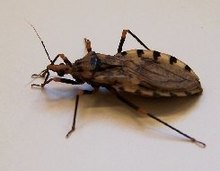Triatominae
| Triatominae | |
|---|---|
 |
|
| Scientific classification | |
| Kingdom: | Animalia |
| Phylum: | Arthropoda |
| Class: | Insecta |
| Order: | Hemiptera |
| Family: | Reduviidae |
| Subfamily: |
Triatominae Jeannel, 1919 |
| Tribes | |
|
Alberproseniini |
|
Alberproseniini
Bolboderini
Cavernicolini
Linshcosteusinii
Rhodniini
Triatomini
The members of Triatominae /traɪ.əˈtɒmᵻniː/, a subfamily of Reduviidae, are also known as conenose bugs, kissing bugs, assassin bugs, or vampire bugs. Other local names for them used in the Latin Americas include barbeiros, vinchucas, pitos and chinches. Most of the 130 or more species of this subfamily are haematophagous, i.e. feeds on vertebrate blood; a very few species feed on other invertebrates (Sandoval et al. 2000, 2004). They are mainly found and widespread in the Americas, with a few species present in Asia, Africa, and Australia. These bugs usually share shelter with nesting vertebrates, from which they suck blood. In areas where Chagas disease occurs (from the southern United States to northern Argentina), all triatomine species are potential vectors of the Chagas disease parasite Trypanosoma cruzi, but only those species (such as Triatoma infestans and Rhodnius prolixus) that are well adapted to living with humans are considered important vectors.
At the beginning of the 19th century Charles Darwin made one of the first reports of the existence of triatomines in America in his Journal and Remarks, published in 1839 and commonly known as The Voyage of the Beagle. The following is an extract which he based on his journal entry dated 26 March 1835:
...
Wikipedia
